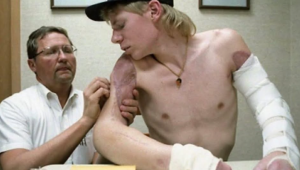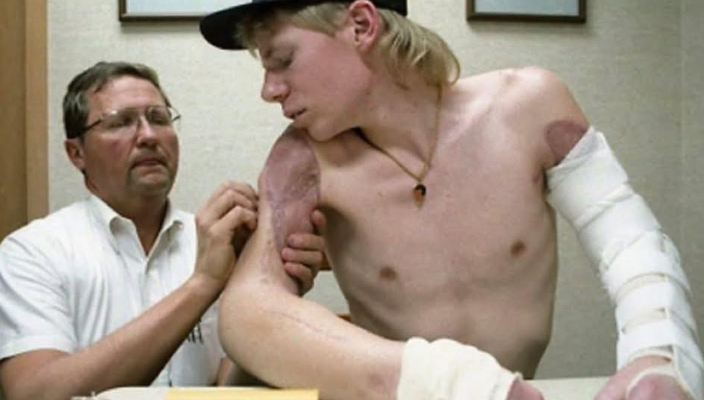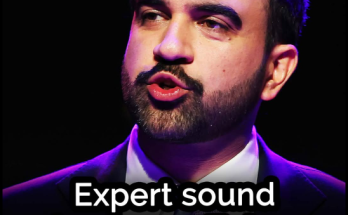“The Boy Who Walked Home Without Arms” The True Story of John Thompson’s Survival and Redemption
On a bitter January morning in 1992, the wind swept across the frozen plains of Hurdsfield, North Dakota, whispering through the barley fields and rattling the windows of the Thompson family farmhouse. Eighteen-year-old John Wayne Thompson, a quiet high school senior with a love for music and aviation, had woken up late. His parents were away in Bismarck, and he had one task: unload barley from a truck using the auger powered by the tractor’s engine.
It was routine work—something John had done countless times before. But that morning, the ground was slick with ice. As he played with his dog, Tuffy, waiting for the barley to finish unloading, he slipped. In a flash, his shirt caught on the exposed power takeoff (PTO) shaft, a rotating piece of machinery that connected the tractor to the auger. The machine didn’t stop. It spun violently, pulling John in.
He lost consciousness.
When he awoke, Tuffy was licking his face. Disoriented, John tried to push himself up—only to realize his right arm was gone. He turned to use his left, but it too had vanished. Both arms had been severed above the elbows. Alone, bleeding, and in shock, John leaned against the tractor tire and screamed. But no one could hear him. The nearest neighbor was miles away.
What followed was nothing short of miraculous.
John stood. Somehow, he walked 100 yards across the icy ground to his house. He tried the sliding glass door—locked. Then he knelt at the front door and, using his teeth, turned the knob. Inside, he grabbed a pencil with his mouth and dialed 911. He then sat in the bathtub, not out of panic, but to avoid bleeding on his mother’s new carpet.
When paramedics arrived, they were stunned. John had lost nearly all his blood. He should not have been alive. But he was conscious, talking, even worried about the tractor still running outside. One of the responders placed a bag beside him—inside were his severed arms.
John was airlifted to Minneapolis. It was his first plane ride. He insisted on sitting up to look out the window, even as he worried about how cold his arms felt. A crew member reminded him: they were packed in ice.
Surgeons worked tirelessly. Dr. Allen Van Beek led the team that reattached both arms. The odds were against them. But the surgery succeeded. John began the long road to recovery.
Rebirth Through Pain
The media swarmed. Headlines called him “The Miracle Teen.” But John hated the spotlight. He wasn’t interested in fame—he wanted to heal. Physical therapy was grueling. He had to relearn everything: how to move, how to eat, how to live. His arms, though reattached, were far from fully functional. But he didn’t give up.
He became a public speaker, not to bask in attention, but to advocate for farm safety. He spoke to thousands, urging them to respect machinery and never take shortcuts. His story wasn’t just about survival—it was about responsibility, resilience, and the power of choice.
John’s transformation wasn’t just physical. He had been a shy boy, uncertain of his future. After the accident, he found purpose. He inspired others not by pretending to be invincible, but by showing vulnerability. He talked about fear, about pain, about the moment he realized he had no arms and still chose to walk home.
The Quiet Hero
Years passed. The media moved on. But John didn’t fade. He built a life. He found joy in small things—his pets, his family, the ability to sing again. He reunited with Dr. Van Beek in 2012, two decades after the accident, when the surgeon received the Sioux Award. Their embrace was quiet, but powerful. Two men bound by a moment that changed both their lives.
John’s story is not just about a freak accident. It’s about what happens after the headlines fade. It’s about the boy who sat in a bathtub to protect his mother’s carpet, who walked 100 yards without arms, who dialed a phone with his teeth. It’s about the man who turned trauma into advocacy, who chose to speak when silence would have been easier.
Legacy of Strength
Today, John Thompson’s name may not be on every newsfeed, but his legacy endures. His story is taught in safety seminars, shared in classrooms, whispered in farmhouses where PTO shafts still spin. He reminds us that survival isn’t just about luck—it’s about grit, clarity, and the will to act.
He also reminds us of something deeper: that transformation often begins in the most brutal moments. That pain can carve out purpose. That a quiet boy from North Dakota can become a symbol of strength—not because he was fearless, but because he faced fear and kept walking.
Final Reflection
John Thompson didn’t just survive losing both arms. He survived the silence, the isolation, the long nights of doubt. He survived the weight of being called a miracle. And in doing so, he became something more than a survivor. He became a teacher.
His story is a testament to the human spirit. To the power of a single decision—to stand up, to walk, to live. And to the truth that sometimes, the most heroic thing a person can do is simply make it home.


